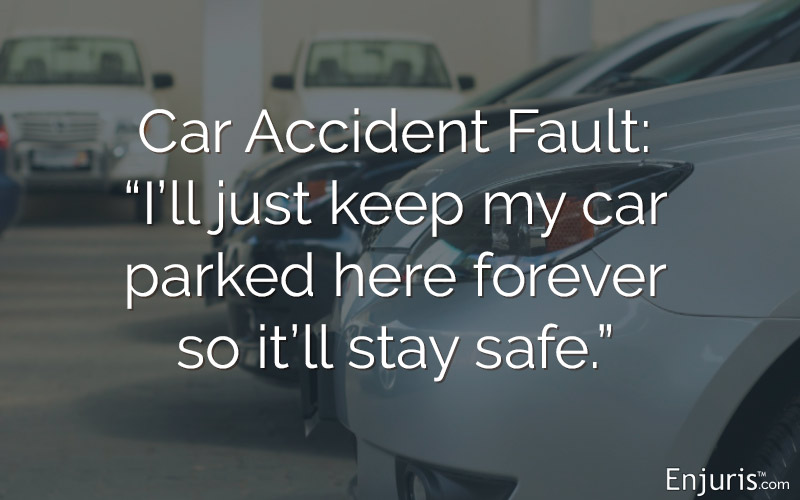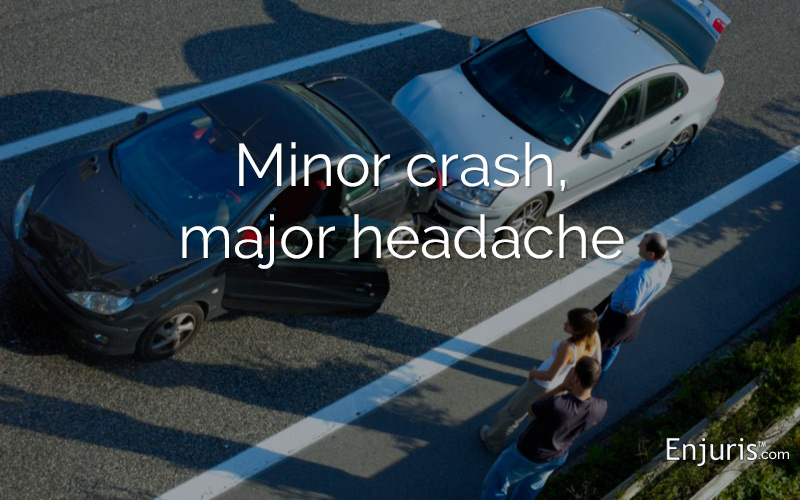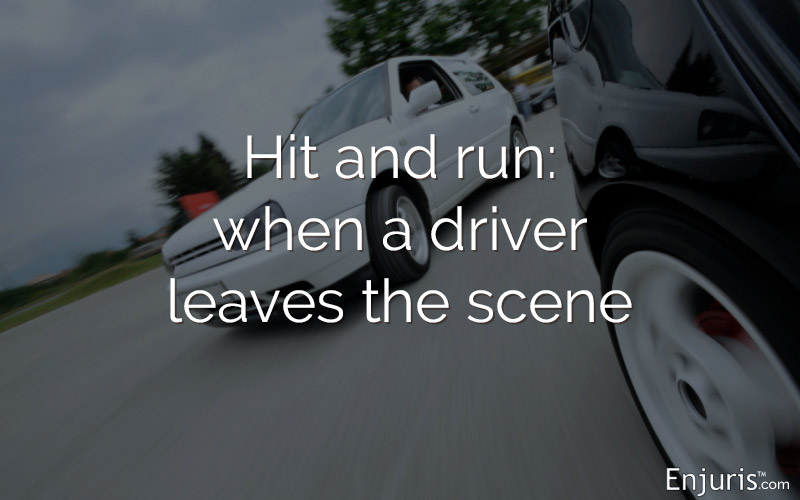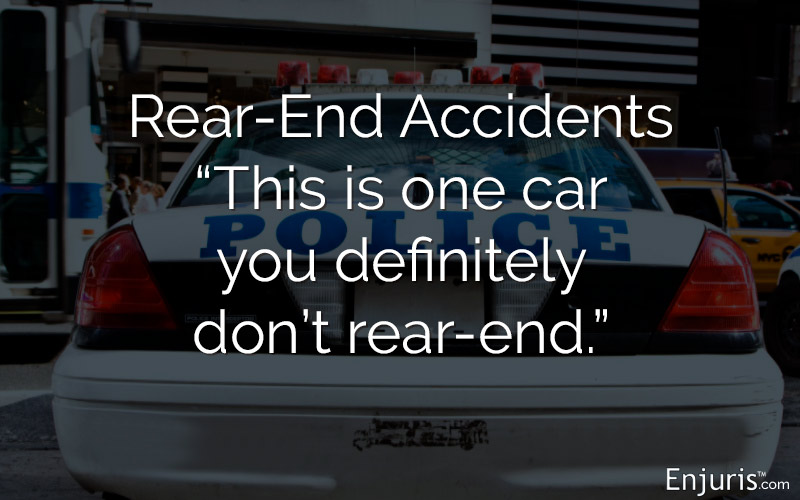Illinois guide to auto insurance requirements, proving fault, and recovering damages after a car crash
According to the Illinois Department of Transportation (IDOT), drivers in Illinois travel roughly 180 billion miles every year. To put this in perspective, you would travel less than 180 billion miles if you flew around the world 7 million times.
With all that driving, accidents are bound to happen. Being in a car accident in Illinois isn't the same as being in a car accident in California or some other state.
Let's take a look at some things you should know about car accidents in the Prairie State.
Illinois car accident statistics
Though Illinois isn't considered one of the 10 most dangerous states to drive in, anyone who frequently drives in and around Chicago knows that it's still plenty dangerous.
According to the most recent data from IDOT, there were 311,679 car crashes in Illinois in 2017. Of these crashes, 93,517 people were injured (66,889 total accidents) and 1,090 were killed (998 total accidents).
| Illinois car crashes by type of collision (2017) | ||
|---|---|---|
| Type of collision | Fatal | Injury |
| Vehicle overturned | 58 | 1,984 |
| Pedestrian | 143 | 4,486 |
| Train | 8 | 26 |
| Pedalcyclist | 26 | 2,663 |
| Animal | 4 | 671 |
| Fixed object | 302 | 7,749 |
| Other object | 8 | 539 |
| Other noncollision | 12 | 582 |
| Parked | 15 | 1,909 |
| Rear-end | 72 | 19,990 |
| Head-on | 112 | 1,107 |
| Sideswipe same direction | 15 | 2,792 |
| Sideswipe opposite direction | 17 | 714 |
| Angle | 81 | 9,205 |
| Turning | 125 | 12,472 |
| Total | 998 | 66,889 |
| Source: Illinois Department of Transportation Crash Facts & Statistics | ||
In 2017, crashes involving fixed objects (such as trees, light poles, walls, etc.) comprised the largest number of fatal crashes (30.3% of all fatal crashes), while rear-end collisions comprised the highest number of injury crashes. Illinois drivers in the 21-34 age group were involved in the highest number of motor vehicle crashes, suffered the highest number of fatalities, and the highest number of total injuries.
How to report a car accident in Illinois
Illinois law requires you to file a written accident report for any accident that resulted in either:
- Death or injury, or
- Property damage of more than $1,500.
The report form is generally provided at the scene by the responding officer. However, the form can also be obtained at any police station or sheriff's office.
Types of car crash damages
Depending on the circumstances of the accident, including how fast the cars were traveling and whether the occupants were wearing seatbelts, injuries can range from minor scrapes and bruises to death.
Common car accident injuries include:
- Whiplash
- Burns
- Scarring
- Traumatic brain injuries and other head injuries
- Spinal trauma
- Broken bones
- Death
Illinois awards both economic and noneconomic damages. "Economic damages" refer to monetary losses resulting from an accident. "Noneconomic damages" refer to losses that don't have a clear dollar value.
Here's a breakdown of what's included in the two categories:
| Types of Damages in Illinois | |
|---|---|
| Economic damages | Noneconomic damages |
| Property damage | Pain and suffering |
| Medical expenses (including future expenses) | Emotional distress |
| Lost income | Loss of consortium |
| Other out of pocket costs | Other non-monetary losses |
In addition, punitive damages (damages awarded to a plaintiff for purposes of punishing the defendant) may be available if the defendant's actions that caused the accident were intentional, outrageous, or grossly negligent.
Determining fault for a car accident
All drivers have a legal duty to drive with reasonable care and to obey all traffic laws. If a driver violates that duty and causes an accident, the driver can be sued for negligence.
To prove negligence in Illinois, you must prove that:
- The other driver owed you a duty. All drivers owe others on the road a duty to drive with a reasonable degree of care.
- The other driver breached their duty. To prove this, you'll have to show that the driver failed to drive with a reasonable degree of care. For example, the driver was texting while driving or they ran a red light.
- You suffered damages as a result of the driver's breach. You must show that the driver's actions (for example, running a red light) caused the accident. In other words, but for the driver's actions, the accident wouldn't have occurred and you wouldn't have suffered damages.
What happens if the plaintiff is partially responsible for the accident?
Illinois follows the modified comparative fault theory. Under this theory, the amount of damages a plaintiff can recover is reduced by a percentage that reflects the plaintiff's degree of fault. However, if a plaintiff is determined to have been 51% or more at fault for the accident, then they will not be able to obtain any compensation from the defendant.
Let's look at an example:
Paul is driving his car on West University Avenue in Champaign, Illinois. Even though it's nighttime, Paul doesn't have his headlights on.
Lauren is driving along South Fair Street. She's texting and driving and, as a result, she doesn't see the stop sign at the intersection of West University Avenue and South Fair Street.
Lauren blows past the stop sign and collides with Paul. Paul suffers a neck injury and sues Lauren for $100,000.
The court finds that Lauren is 90% at fault for the accident (for failing to stop at the stop sign) and that Paul is 10% at fault (for driving without his headlights on at night).
In the above example, Paul would only be able to recover $90,000 due to the modified comparative fault rule.
Had the court found that Paul was 51% at fault (or more), he wouldn't be able to recover any damages.
Car accident statute of limitations
Have you heard the term "statute of limitations" and wondered what the heck it means?
The statute of limitations is a state law that sets a time limit on your right to file a lawsuit. How long you have to file depends on the type of harm and the type of case.
If you fail to file your lawsuit before the deadline, the court will dismiss your claim with prejudice, except in very rare situations. This means you won't be able to recover any damages based on the accident (at least not through a lawsuit, you might still be able to recover some insurance money).
What if I'm suing the government?
The applicable statute of limitations is a little different if you were injured by a government employee (for example, you were hit by a city bus). A person seeking to file a claim against the government must take 1 of 2 steps:
- File a notice of the claim with the Attorney General and the Clerk of the Court of Claims within 1 year of the date of injury. This written notice must list the name and home address of the injured person, the date and time of the accident, the place where it occurred, a brief description of the accident, and the name and address of the claimant's attending physician. So long as this notice is filed within 1 year, you have 2 years from the date of the accident to file a lawsuit.
- File a lawsuit with the Court of Claims within 1 year of the date the accident occurred. If the claim is filed within 1 year, notice isn't necessary.
Auto insurance requirements in Illinois
Every Illinois driver is required to maintain—at a minimum—the following car insurance coverage amounts:
| Minimum Car Insurance Coverage Requirements in Illinois | |
|---|---|
| Bodily injury liability for 1 person in an accident | $25,000 |
| Bodily injury liability for all persons harmed in 1 accident | $50,000 |
| Property damage per accident | $20,000 |
Keep in mind that the minimum requirements listed above cover bodily injuries and property damage caused by the insured individual and sustained by someone other than the insured. In other words, if you cause a car accident, then your liability insurance pays for the other person's injuries and damages.
8 steps to take after a car accident
After a car accident, you may be rattled and overwhelmed. Regardless, try to keep the following 8 steps in mind so you can set yourself up to recover the damages you deserve.
Step 1: Stop your vehicle and help anyone who's injured (including yourself)
In Illinois, the driver of any vehicle involved in a motor vehicle accident that results in injury or property damage is required to:
- Stop their vehicle at the scene or as close to the scene as possible, and
- Render reasonable assistance to any injured persons.
The penalties for failing to stop and render aid can range from a fine to significant jail time.
Step 2: Call the police
Even if the motor vehicle accident is minor and you think you can handle the aftermath on your own, it's a good idea to contact the police. Calling the police starts a paper trail that will end with the responding officer drafting and filing a police report. This police report (and the information it contains) could prove valuable if you decide to file a claim or a personal injury lawsuit down the road.
Step 3: Exchange information with the other driver
In Illinois, drivers are required by law to provide the following information to the other drivers involved in an accident:
- Name
- Current address
- Registration number
- Driver's license (if requested)
The penalties for failing to provide the required information can be severe.
Step 4: Collect witness information
Witnesses are notoriously difficult to track down after an accident. As a result, you'll want to gather all the evidence you can at the time of the accident. This includes the following information from every witness:
- Name
- Address
- Telephone number
- A telephone number of a close friend or family member (in case the witness's telephone number changes)
If the witness is willing to provide a statement (whether in writing or recorded using your phone), be sure to take them up on the offer. However, it's important not to harass or pressure the witness to provide a statement.
Step 5: Take pictures and gather any other evidence
Our memories aren't always reliable. If you weren't responsible for the accident, write down what happened as soon as possible. In addition, be sure to take photographs of the scene, as well as any damage to your vehicle or body.
Step 6: Report the accident
As discussed above, Illinois requires that you report most car accidents. This requirement is another good reason to call the police following an accident.
Step 7. Notify your insurer
If the car accident was your fault, you'll want to file a claim with your insurance provider. If the accident wasn't your fault, you can either file a claim with the at-fault party's insurance provider or with your own insurance provider. If you file a claim with your own insurance provider, they'll seek reimbursement from the at-fault party's insurance provider.
Step 8. Talk to an attorney
After you report the accident, there will be an investigation and your claim will either be rejected or the insurance provider will make an offer. Before accepting any offer, consider talking to an attorney.
Remember, once you accept an offer (and sign a release), you can't sue for more money at a later date. This can be a huge problem if you later discover that your injuries are worse than you thought. An attorney can help make sure you get everything you deserve.
Step 9: Document everything
The best thing you can do for your claim is to keep good records. In addition to keeping copies of driver information, witness information, and any photographs you may have taken, this means keeping track of your medical expenses and the day-to-day impact of your injuries.

Damages worksheet to track expenses for your injury claim (medical treatment, property damage, lost wages, prescriptions)
Download in PDF format

Sample accident journal/diary to help you document the effect on your daily life
Download in PDF format
- What You Need to Know About Illinois Car Accidents
- Distracted Driving Accidents & Laws in Illinois
- Guide to Bicycle Accidents in Illinois
- Guide to Illinois Auto Insurance Laws and Requirements
- Guide to Pedestrian Accidents in Illinois
- Guide to Rideshare & Taxi Accidents in Illinois
- Illinois Drunk Driving Accidents, Laws & Injury Compensation
- Illinois Guide to Bus Accidents
- Illinois Hit-and-Run Accidents
- Illinois Train Accidents & Railroad Injury Claims
- Motorcycle Accidents and Lawsuits in Illinois
Did you know that car accident law varies by state?
Hurt in a car crash? You may find these resources helpful
Need a lawyer?
What does an injury lawyer do?
A personal injury lawyer helps individuals who have sustained injuries in accidents to recover financial compensation. These funds are often needed to pay for medical treatment, make up for lost wages and provide compensation for injuries suffered. Sometimes a case that seems simple at first may become more complicated. In these cases, consider hiring an experienced personal injury lawyer. Read more
Common car accidents





















